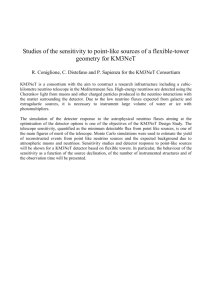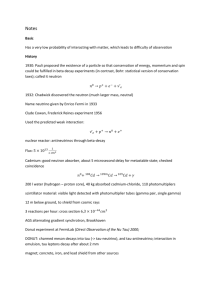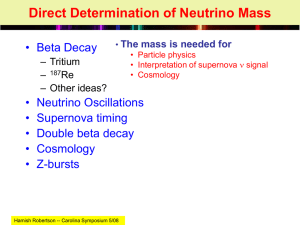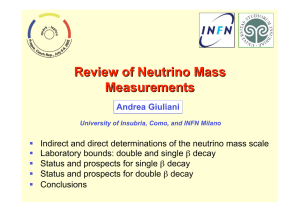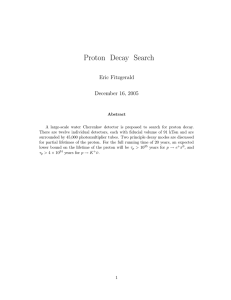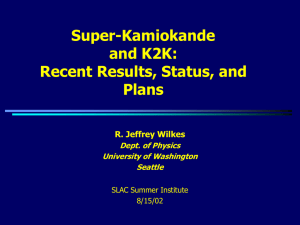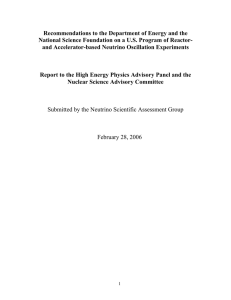letter, dated 19 January
advertisement
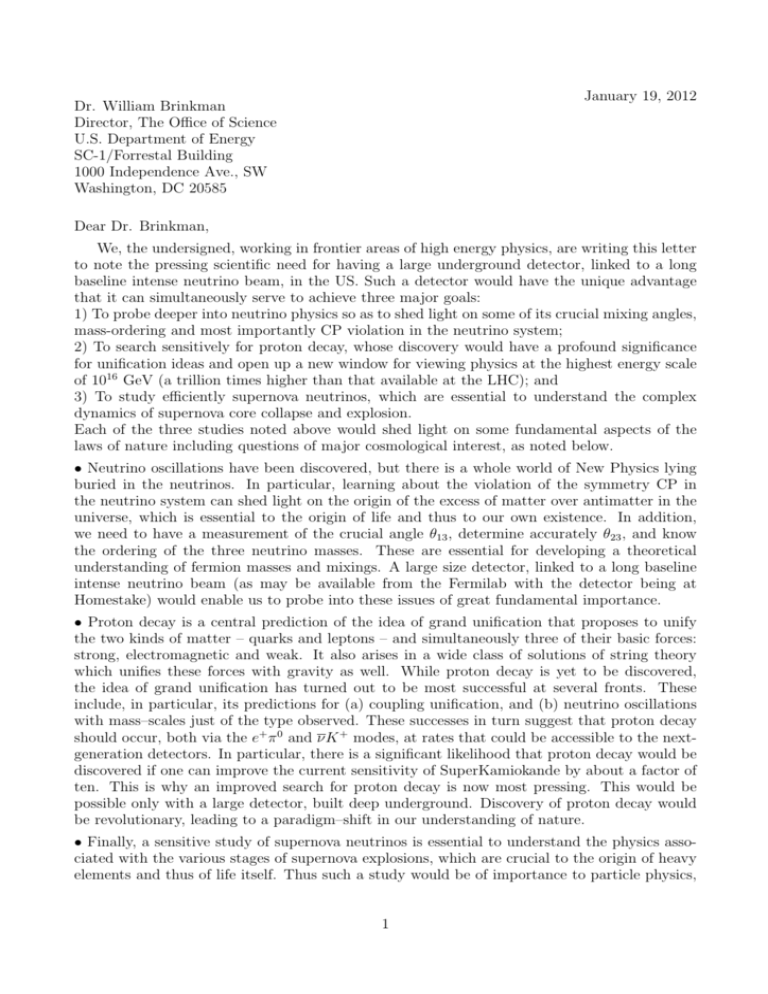
January 19, 2012 Dr. William Brinkman Director, The Office of Science U.S. Department of Energy SC-1/Forrestal Building 1000 Independence Ave., SW Washington, DC 20585 Dear Dr. Brinkman, We, the undersigned, working in frontier areas of high energy physics, are writing this letter to note the pressing scientific need for having a large underground detector, linked to a long baseline intense neutrino beam, in the US. Such a detector would have the unique advantage that it can simultaneously serve to achieve three major goals: 1) To probe deeper into neutrino physics so as to shed light on some of its crucial mixing angles, mass-ordering and most importantly CP violation in the neutrino system; 2) To search sensitively for proton decay, whose discovery would have a profound significance for unification ideas and open up a new window for viewing physics at the highest energy scale of 1016 GeV (a trillion times higher than that available at the LHC); and 3) To study efficiently supernova neutrinos, which are essential to understand the complex dynamics of supernova core collapse and explosion. Each of the three studies noted above would shed light on some fundamental aspects of the laws of nature including questions of major cosmological interest, as noted below. • Neutrino oscillations have been discovered, but there is a whole world of New Physics lying buried in the neutrinos. In particular, learning about the violation of the symmetry CP in the neutrino system can shed light on the origin of the excess of matter over antimatter in the universe, which is essential to the origin of life and thus to our own existence. In addition, we need to have a measurement of the crucial angle θ13 , determine accurately θ23 , and know the ordering of the three neutrino masses. These are essential for developing a theoretical understanding of fermion masses and mixings. A large size detector, linked to a long baseline intense neutrino beam (as may be available from the Fermilab with the detector being at Homestake) would enable us to probe into these issues of great fundamental importance. • Proton decay is a central prediction of the idea of grand unification that proposes to unify the two kinds of matter – quarks and leptons – and simultaneously three of their basic forces: strong, electromagnetic and weak. It also arises in a wide class of solutions of string theory which unifies these forces with gravity as well. While proton decay is yet to be discovered, the idea of grand unification has turned out to be most successful at several fronts. These include, in particular, its predictions for (a) coupling unification, and (b) neutrino oscillations with mass–scales just of the type observed. These successes in turn suggest that proton decay should occur, both via the e+ π 0 and νK + modes, at rates that could be accessible to the nextgeneration detectors. In particular, there is a significant likelihood that proton decay would be discovered if one can improve the current sensitivity of SuperKamiokande by about a factor of ten. This is why an improved search for proton decay is now most pressing. This would be possible only with a large detector, built deep underground. Discovery of proton decay would be revolutionary, leading to a paradigm–shift in our understanding of nature. • Finally, a sensitive study of supernova neutrinos is essential to understand the physics associated with the various stages of supernova explosions, which are crucial to the origin of heavy elements and thus of life itself. Thus such a study would be of importance to particle physics, 1 nuclear physics and astrophysics. Supernova neutrinos can be studied sensitively only at a large underground detector. They are a sure bonus from nature that we can not afford to miss. We are very aware that the size of the detector may be limited by the present budgetary constraints. The minimum initial size, that would allow a major boost towards serving the needed physics goals, should be determined by the experimenters who will be involved, in discussion with the DOE. However, as an example, the LBNE collaboration has shown that a 200 kt (fiducial volume) Water Cherenkov Detector would have the potential (better than SuperK) for discovering proton decay especially in the e+ π 0 mode, and would provide very significant sensitivity to CP violation in neutrino oscillation, to the neutrino mass ordering and supernova neutrinos. An equivalent 34 kt Liquid Argon detector would do likewise (it would in fact do better for proton decaying via the νK + mode). It is important that either detector be built deep underground. Such a detector, and the intensity of the associated neutrino beam from Fermilab, should be upgraded in the future, as physics may demand, and funding would permit. Together with the large detector, built underground, the addition of suitable devices in the same deep site can help improve sensitivities to studies of neutrinoless double beta decay and detection of dark matter, both of which are of crucial fundamental importance. To sum up, a large size detector, built deep underground, is urgently needed to address a set of fundamental issues in particle physics as well as astrophysics. The discovery potential of such a detector is high in all three realms mentioned above. With its unique multi-purpose value and its physics significance, such a large size detector would be one of the greatest assets to the US and the world as a whole. It would greatly complement the physics that may be learned from the Large Hadron Collider. Thereby it would certainly help US to gain and maintain its leadership in the frontier of particle physics for decades to come. Submitted respectfully by c.c. Dr. James Siegrist (Office of Science, DOE) Jogesh C. Pati c.c. Dr. Pier Oddone (Director, Fermilab) Professor Emeritus, University of Maryland c.c. Dr. James Strait (LBNE Project Manager) (patijogesh@gmail.com, (650) 654-8802) On behalf of the signatories listed below: ————————————————————————————————————————— Stephen L. Adler (Institute for Advanced Study, Princeton) Carl H. Albright (Northern Illinois University, DeKalb) Richard Arnowitt (Texas A & M University, College Station) Kaladi S. Babu (Oklahoma State University, Stillwater) Howard Baer (University of Oklahoma, Norman) A. Baha Balantekin (University of Wisconsin, Madison) Stanley J. Brodsky Mu-Chun Chen (University of California, Irvine) Andre de Gouvea (Northwestern University) Nilendra G. Deshpande (University of Oregon, Eugene) Savas Dimopoulos (Stanford University) Jonathan L. Feng (University of California, Irvine) 2 Paul H. Frampton (University of North Carolina, Chapel Hill) Howard Georgi (Harvard University) Sheldon L. Glashow (Boston University) Boris Kayser Christopher Kolda (University of Notre Dame) Paul Langacker (Institute for Advanced Study & Princeton University) Ernest Ma (University of California, Riverside) Kalyana T. Mahanthappa (University of Colorado, Boulder) William J. Marciano Rabindra N. Mohapatra (University Maryalnd, College Park) Dimitri V. Nanopoulos (Texas A & M University, College Station) Pran Nath (Northeastern University) Yasunori Nomura (University of California, Berkeley) Sandip Pakvasa (University of Hawaii, Manoa) Jogesh C. Pati (University of Maryland, College Park) Joseph Polchinski (KITP, University of California, Santa Barbara) Stuart Raby (The Ohio State University, Columbus) John H. Schwarz (California Institute of Technology) Qaisar Shafi (University of Delaware, Newark) Robert Shrock (YITP, Stony Brook University) Amarjit Soni Raman Sundrum (University of Maryland, College Park) Leonard Susskind (Stanford University) Barbara Szczerbinska (Dakota State University, Madison) Cumrun Vafa (Harvard University) Carlos E.M. Wagner (University of Chicago) Steven Weinberg (University of Texas, Austin) Frank Wilczek (Massachusetts Institute of Technology) Edward Witten (Institute for Advanced Study, Princeton) Anthony Zee (KITP, University of California, Santa Barbara) P.S. Affiliations of some of the signatories are not shown to emphasize that they are signing this letter as private citizens. Contact information: Prof. Jogesh C. Pati 3413 Brittan Ave. San Carlos, CA 94070 Ph: (650) 654-8802 Email: patijogesh@gmail.com 3
